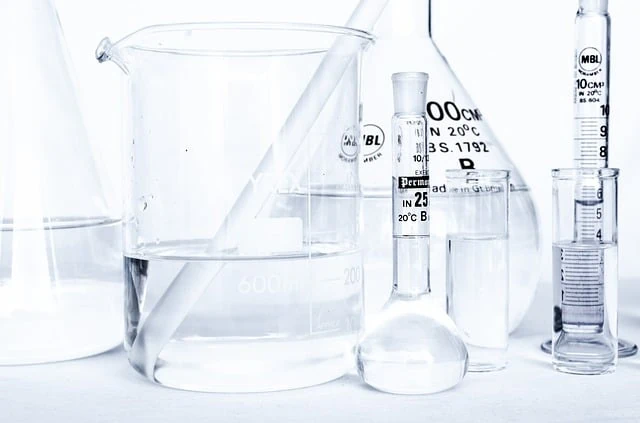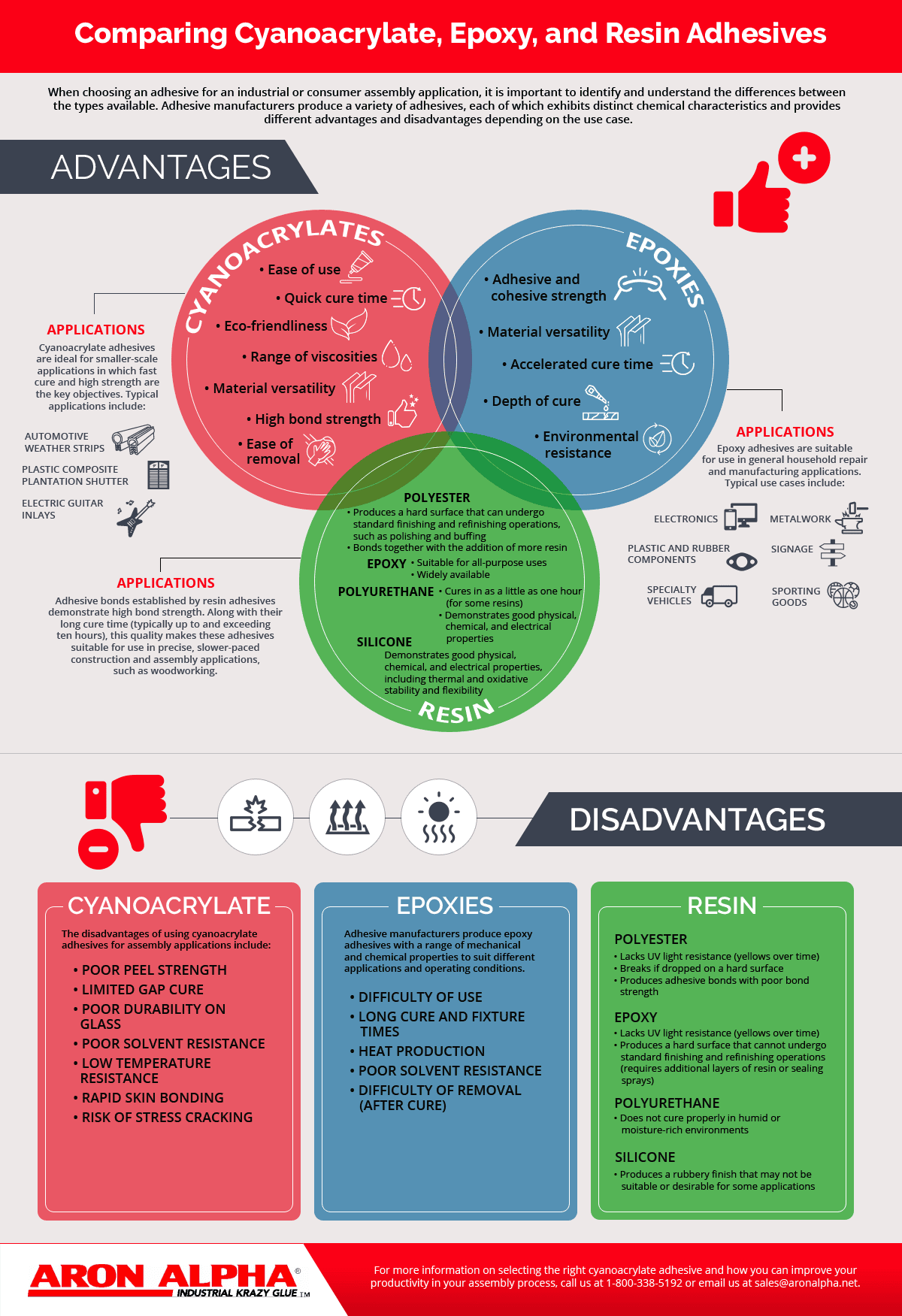Comparing Cyanoacrylate, Epoxy, and Resin Adhesives

When choosing an adhesive for an industrial or consumer assembly application, it is important to identify and understand the differences between the types available. Adhesive manufacturers produce a variety of adhesives, each of which exhibits distinct chemical characteristics and provides different advantages and disadvantages depending on the use case.
Some of the most common types of adhesive employed in the industrial and consumer sectors include cyanoacrylate, epoxy, and resin adhesives. These are umbrella terms for broader ranges of adhesive compounds used in homes and industrial facilities. Although some people use these terms interchangeably, each of these compounds has a unique chemical makeup and ideal use cases. While there are some overlapping applications, the adhesives are most effective when used for their intended purposes.
The following information focuses on the differences between cyanoacrylates, epoxies, and resins, exploring their properties, advantages and disadvantages, and typical applications.
Key Differences Between Cyanoacrylates, Epoxies, and Resins
Cyanoacrylates—also referred to as instant adhesives—are a single-component adhesive technology made from cyanoacrylate monomer compounds (typically ethyl-2 cyanoacrylate). As suggested by their name, these adhesives rapidly cure when exposed to moisture in the atmosphere and on substrate materials, and are ideal when fast cure and high-strength are the key objectives.
Epoxy adhesives are compounds typically made from two parts—a resin (Part A) and hardener (Part B)— combined at a set mix ratio and cured at room temperature. Once a user mixes a two-part epoxy, they have a specific timeframe, based on the formulation, in which to use the adhesive before it hardens. This timeframe is known as the adhesive’s pot life. One-part system epoxies are also available, but these adhesive compounds require additional catalysts, such as heat, UV light, or moisture, to cure and set the adhesive bond.
Although all epoxy adhesives contain resins, resin adhesives (also known as resinous solvent adhesives) contain other types of resinous compounds—such as phenols, amines, and polyurethanes—that produce different adhesive properties. Like epoxies, resin adhesives consist of two-part systems that require curing periods to set the adhesive bond.
Cyanoacrylate Properties
Cyanoacrylates are available in several different formulations for use on both porous and non-porous materials. For polyolefins and difficult-to-bond plastics and elastomers, primers are available to facilitate the formation of an adhesive bond.
Advantages of Cyanoacrylates
Cyanoacrylate adhesives provide a number of advantages in assembly applications, such as:
- Ease of use. Cyanoacrylate adhesives employ a one-part system that generally does not require additional curing agents or catalysts to initiate the curing process. Additionally, they are easy to dispense in automated systems.
- Quick cure time. Curing and setting of the adhesive occur rapidly at room temperature.
- Eco-friendliness. These adhesive compounds do not contain solvents, minimizing their environmental impact.
- Range of viscosities. Cyanoacrylates are available in a variety of formulations with a range of viscosities to suit different applications.
- Material versatility. They demonstrate excellent adhesion when applied to many substrates.
- High bond strength. They also exhibit excellent bond strength in shear and tensile mode.
- Ease of removal. Although cyanoacrylates are fast-curing, they are easy to remove in their liquid or hardened state with acetone-based solutions, such as nail polish remover.
- Primers available for polyolefins and difficult to bond plastics and elastomers
Disadvantages of Cyanoacrylates
The disadvantages of using cyanoacrylate adhesives for assembly applications include:
- Poor peel strength. An adhesive bond formed by a cyanoacrylate adhesive is likely to fail when subjected to peel stress.
- Limited gap cure. Cyanoacrylates are not suitable for bonding substrates with large gaps as the adhesive may form a weaker adhesive bond or not set fully.
- Poor durability on glass. Cyanoacrylates are not suitable for use on glass as the smooth surface does not facilitate the formation of a strong adhesive bond.
- Poor solvent resistance. Exposing adhesive bonds formed by cyanoacrylates to solvents can weaken the overall bond strength.
- Low temperature resistance. Compared to other types of adhesives, such as epoxies, cyanoacrylates withstand a smaller range of temperatures.
- Rapid skin bonding. Although these materials are easily removed with acetone-based solutions, they quickly adhere to skin and bond skin together.
- Risk of stress cracking. When used on plastic substrates, cyanoacrylates may cause stress fractures as they cure and harden.
Applications of Cyanoacrylates
Cyanoacrylate adhesives are ideal for smaller-scale applications in which fast cure and high strength are the key objectives. Typical applications include general household repairs and use on automotive weather strips, plastic composite plantation shutters, and electric guitar inlays.
Epoxy Properties
Adhesive manufacturers produce epoxy adhesives with a range of mechanical and chemical properties to suit different applications and operating conditions.
Advantages of Epoxies
The advantages of using epoxy adhesives for assembly applications include:
- Adhesive and cohesive strength. Epoxy adhesives form strong, durable bonds that withstand shear and peel stress.
- Material versatility. Epoxies demonstrate excellent adhesion when applied to many substrates, including dissimilar substrates and irregular-textured materials.
- Accelerated cure time. The cure period of epoxy can be accelerated with heat.
- Depth of cure. Epoxies are suitable for use on materials with large gaps as the adhesive sets properly regardless of the thickness or depth of the application.
- Environmental resistance. Compared to other types of adhesives, such as cyanoacrylates, epoxies withstand a broader range of temperatures and environmental conditions.
Disadvantages of Epoxies
Epoxy adhesives provide several disadvantages when used in assembly applications, such as:
- Difficulty of use. Epoxies are available in one-part and two-part systems. The two-part systems require mixing before application, while one-part systems require additional curing agents or catalysts to initiate the curing process. Additionally, once mixed, two-part systems have a limited pot life.
- Long cure and fixture times. Compared to cyanoacrylates, epoxies require a longer cure period to set the adhesive bond fully.
- Heat production. Exothermic heat produced by the epoxy curing process may be problematic for certain materials and applications.
- Difficulty of removal (after cure). Before an epoxy hardens, it can be removed with acetone or isopropyl alcohol (IPA). However, once it hardens, it is difficult—if not impossible—to remove without damaging the surface of the substrate.
Applications of Epoxies
Epoxy adhesives are suitable for use in general household repair and manufacturing applications. Typical use cases include:
- Electronics
- Metalwork
- Plastic and rubber components
- Signage
- Specialty vehicles
- Sporting goods
Resin Properties
Resin adhesives are available in powder, spray, emulsion, and liquid forms. Adhesive manufacturers employ several different types of resins to produce them. The four most common resins used include polyester, epoxy, polyurethane, and silicone. Each of these types is characterized by distinctive properties and is suitable for use in different assembly applications.
Table 1 below outlines the characteristics of each type of resin.
| Type of Resin | Properties, Advantages, and Disadvantages |
| Polyester |
Properties
Advantages
Disadvantages
|
|
Epoxy |
Properties
Advantages
Disadvantages
|
|
Polyurethane |
Properties
Advantages
Disadvantages
|
|
Silicone |
Properties
Advantages
Disadvantages
|
In addition to these four types of resins, other examples of resins used in adhesives include alkyds, amines, phenols, polyamides, polycarbonates, polyether, and polyimides.
Applications of Resins
Adhesive bonds established by resin adhesives demonstrate high bond strength. Along with their long cure time (typically up to and exceeding ten hours), this quality makes these adhesives suitable for use in precise, slower-paced construction and assembly applications, such as woodworking.
Removing Cyanoacrylates and Epoxies
Epoxy, before it hardens, may be removed with acetone or Isopropyl alcohol (IPA). Once it hardens it is very difficult, if not impossible, to remove without damage to the surface it was applied to. Cyanoacrylates can be removed, in either liquid or solid state, with acetone (aka fingernail polish remover).
Contact Aron Alpha for Additional Adhesive Information
We hope that this information has been helpful in providing a high-level overview of some of the different adhesive technologies available.
For more information on selecting the right cyanoacrylate adhesive and how you can improve your productivity in your assembly process, call us at 1-800-338-5192, email us at sales@aronalpha.net, give us a call at 1-800-338-5192, or get in touch with our team directly.





